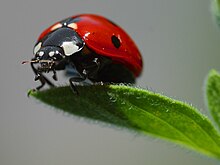A ladybird. From lady bird Virgin Mary , Jesus’ mother. Compare German Marienkäfer ( literally “ Mary beetle/bug ” ) .
ladybird (plural ladybirds
Any of the Coccinellidae beetles , typically having a round shape and red or yellow spotted elytra .
Synonyms: ( North America ) ladybug ( preferred by some scientists ) lady beetle ( obsolete, Britain ) ladycow ( obsolete, Britain ) lady fly ( archaic, dialectal UK ) bishy barnabee 1914 , Entomological Society of America, Annals of the Entomological Society of America , Volume 7, page 81 ,
During this time, they eat about 825 Toxoptera per ladybird , making an average of about twenty-five per day to each ladybird . 1927 , Hamilton Wright Mabie, Edward Everett Hale, and William Byron Forbush (editors), Childhood′s Favorites and Fairy Stories: The Young Folks Treasury , Volume 1, Gutenberg eBook #19993 ,
Lady-bird , lady-bird , fly away home, / Thy house is on fire, thy children all gone: / All but one whose name is Ann, / And she crept under the pudding-pan.1976 September 30, Denis Owen, Ladybird , ladybird , fly away homeNew Scientist page 686 ,
Ladybirds , unlike most beetles, enjoy considerable popularity: they are attractive to look at and are well-known as useful predators of aphids—the greenfly and blackfly that destroy garden plants and crops.2008 , John L. Capinera, Encyclopedia of Entomology , Springer-Verlag New York, 2nd Edition, page 2130 ,
Perhaps it was a sense of lack of effectiveness of native ladybirds in rapid and complete control of aphid infestations that led to attempts to import additional aphid-feeding ladybird species into North America. The term ladybird ladybug
member of Coccinellidae
Afrikaans: liewenheersbesie skilpadbesie skilpadkewer
Albanian: mollëkuqe (sq) , burbuqe (sq) , nuse pashke f buburezë (sq) f buburizë (sq) f shtatpikaloshe f pikaloshe f
Arabic: دُعْسُوقَة f ( duʕsūqa )
Gulf Arabic: اُم عَلِي f
Hijazi Arabic: دعسوقة f ( daʕsūqa )
Aramaic:
Assyrian Neo-Aramaic: ܒܵܛܝܼܒܵܛܘܿ ( bāṭībāṭō )
Armenian: զատիկ (hy) ( zatik )
Azerbaijani:
Abjad: ملا قوشى ( mollā-qūshi )
Roman: parabüzən xallı bəzək xanımböcəyi mollaquşu uçağan ( dialectal ) , papıştikən ( dialectal )
Basque: marigorringo (eu)
Belarusian: каро́ўка-баго́ўка f ( karóŭka-bahóŭka )
Breton: buoc'hig-Doue (br) f
Bulgarian: кали́нка (bg) f ( kalínka ) , кали́нка-мали́нка f ( kalínka-malínka ) , божа́ кра́вичка f ( božá krávička )
Catalan: marieta (ca) f
Chinese:
Cantonese: 瓢蟲 / 瓢虫 ( piu4 cung4 )
Mandarin: 瓢蟲 / 瓢虫 (zh) ( piáochóng )
Chuvash: уяр ( ujar )
Crimean Tatar: sırlı böcek
Czech: slunéčko (cs) n sluníčko (cs) n beruška (cs) f ( colloquial )
Danish: mariehøne (da) c
Dutch: lieveheersbeestje (nl) n
Esperanto: kokcinelo mariskarabo
Estonian: lepatriinu (et)
Finnish: leppäkerttu (fi) , leppäpirkko (fi)
French: coccinelle (fr) f
Galician: xoaniña (gl) f papasol m reirrei m maruxiña f voaniña f
Georgian: ჭიამაია ( č̣iamaia )
German: Marienkäfer (de) m Alemannic German: Mariiechääferli n
Greek: πασχαλίτσα (el) f ( paschalítsa )
Greenlandic: aamanganiaq
Hebrew: מושית f ( moshít ) , פָּרַת מֹשֶׁה רַבֵּנוּ (he) f ( parát moshé rabénu )
Hindi: सोनपाखरा ( sonpākhrā ) , सोनपंखी ( sonpaṅkhī ) , सुररखी ( surarkhī )
Hungarian: katicabogár (hu)
Icelandic: maríuhæna (is) f maríubjalla (is) f
Indonesian: kepik (id)
Ingrian: jumalanlehmä
Interlingua: coccinella
Irish: bóín Dé (ga) f bó shamhraidh f bóín samhraidh f
Italian: coccinella (it) f
Japanese: テントウムシ (ja) ( tentōmushi ) , 天道虫 (ja) ( てんとうむし, tentōmushi )
Kabuverdianu: juaninha
Khmer: អណ្ដើកមាស ( ɑndaǝk mieh )
Korean: 무당벌레 (ko) ( mudangbeolle )
Ladin: chëifer dla Madona m
Latvian: mārīte f
Lithuanian: boružė f
Low German:
German Low German: Sünnenküken
Luxembourgish: Himmelsdéierchen (lb) n
Macedonian: бубамара f ( bubamara ) , божа кравица f ( boža kravica )
Malay: kumbang (ms)
Maltese: nannakola f
Maori: mumutawa ngoikura
Navajo: chʼosh łitsxooí
Norman: paqu'nôte f
North Frisian: goodshenk
Norwegian: marifly marihøne (no)
Ottoman Turkish: قفتان بوجكی ( kaftan böceği ) , خانم بوجكی ( xanum böjeyi )
Persian: کفشدوزک (fa) ( kafšduzak )
Plautdietsch: Howapieetje n
Polish: biedronka (pl) f boża krówka (pl) f
Portuguese: joaninha (pt) f
Punjabi: ਬੀਰ ਵਹੁਟੀ f ( bīr vahuṭī )
Romanian: buburuză (ro) f gărgăriță (ro) f mămăruță (ro) f
Romansch: bau da Nossadunna m
Russian: бо́жья коро́вка (ru) f ( bóžʹja koróvka )
Scottish Gaelic: daolag bhreac dhearg f
Serbo-Croatian:
Cyrillic: бубамара f
Roman: bubamara (sh) f
Sicilian: papuzzedda f
Slovak: lienka f pánbožkova kravička f
Slovene: pikapolonica (sl) f
Spanish: mariquita (es) f catarinita f ( Mexico ) , chinita (es) f ( Chile ) , San Antonio (es) m ( Uruguay ) , sarantontón f ( Canary Islands ) , vaquita de San Antonio f ( Argentina ) , santanita f sananica f ( Spain )
Swedish: nyckelpiga (sv)
Tagalog: marikita
Thai: แมลงเต่าทอง ( má-laeng dtào tɔɔng ) , เต่าทอง (th) ( dtào tɔɔng )
Turkish: uğur böceği (tr)
Turkmen: kekene (tk)
Tuvan: бичии доос-кара ( biçii doos-kara )
Ukrainian: со́нечко (uk) n ( sónečko ) , бо́жа корі́вка f ( bóža korívka )
Uyghur: خانقىز ( xanqiz )
Uzbek: xonqizi (uz)
Vietnamese: bọ rùa (vi) , cánh cam
Welsh: buwch goch gota (cy) f buchod coch cwta (cy) f pl
West Frisian: leavehearsbistke n
Yiddish: משה רבינוס קיִעלע n ( moyshe rabeynes kiele ) , משה רבנוס בהמהלע n ( moyshe rabeynes beheymele ) , משה רבנוס פֿערדעלע n ( moyshe rabeynes ferdele )
Zhuang: nengzgoemj
Zulu: umanqulwana

 Coccinellidae on Wikipedia.Wikipedia
Coccinellidae on Wikipedia.Wikipedia